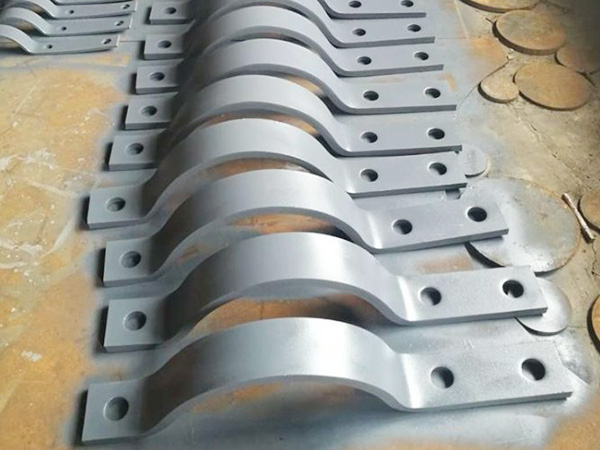Long-Term Maintenance of Pipe Insulation Supports: Tips to Extend Service Life
Author:Mingde Time:2025-08-11 15:50:14 Click:93
Why Pipe Insulation Support Maintenance Matters
In industrial facilities—whether power generation, oil & gas, or chemical processing—pipe insulation supports play a critical role in both thermal efficiency and mechanical stability. While often overlooked, poor maintenance can lead to insulation degradation, corrosion under insulation (CUI), and ultimately, pipeline failure.
Choosing the right supplier is the first step toward long-term reliability. A Pipe Clamp Manufacturer with experience in custom engineering and robust materials will significantly reduce the chances of premature wear compared to mass-market or unverified products.


Common Problems from Neglected Pipe Insulation Supports
Before we dive into solutions, it's essential to understand what can go wrong. Pipe supports are frequently exposed to:
·Moisture ingress, leading to CUI
·Temperature cycling, causing material fatigue
·Mechanical vibration, loosening connections over time
·Improper insulation fit, creating thermal bridges and weak points
·Deformation or corrosion of clamps, particularly in high-humidity environments
Failure to address these risks early can result in pipe movement, insulation loss, and eventual system failure.
Warning Signs You Shouldn’t Ignore
Early indicators of compromised insulation support include:
·Rust or discoloration at support points
·Sagging or misaligned insulation
·Cracks in clamp coatings
·Condensation near brackets
·Abnormal thermal loss or surface temperature variation
Regular visual inspections can catch many of these symptoms before they become critical.
Best Practices for Long-Term Maintenance
1. Routine Inspection and Documentation
Set up a structured inspection schedule—ideally every 6 to 12 months—depending on your facility’s exposure to temperature, humidity, and mechanical loads.
Create a checklist for:
·Clamp integrity
·Insulation compression or displacement
·Fastener corrosion or wear
·Moisture detection beneath insulation
Digital documentation can help track support condition over time.
2. Apply and Maintain Protective Coatings
Paint or galvanization on pipe clamps serves as the first line of defense against corrosion. Periodically inspect these coatings and reapply where necessary. In highly corrosive environments, stainless steel or duplex materials are recommended.
3. Use Thermal Break Inserts to Reduce Heat Transfer
High-performance supports use phenolic or polyisocyanurate inserts to eliminate thermal bridging. These reduce both energy loss and the risk of condensation at support points.
Ask your Pipe Clamp Manufacturer whether your existing system can be retrofitted with these inserts to improve performance.
4. Avoid Over-Tightening Clamp Assemblies
Incorrect torque during installation can damage insulation layers or deform the clamp. Use calibrated tools and follow torque specifications provided by the manufacturer. Under-tightening can cause vibration-related failure; over-tightening can crush insulation.
5. Drainage and Vapor Barrier Maintenance
Supports should be located where drainage is possible. Ensure vapor barriers and jacketing remain sealed around supports—especially horizontal lines where water might pool. Trapped moisture is one of the main causes of CUI.


How a Specialized Pipe Clamp Manufacturer Adds Value
Generic clamp providers often sell basic products that may not hold up in demanding environments. In contrast, a dedicated Pipe Clamp Manufacturer can offer:
·Custom-designed support systems tailored to your insulation type and pipe diameter
·Corrosion-resistant materials (e.g., 316L stainless steel, hot-dip galvanized steel)
·Compatibility with high-temp and cryogenic applications
·Quick response on replacements or technical guidance
·Integrated insulation inserts, reducing energy loss and mechanical stress
When planning long-term maintenance strategies, the supplier's expertise plays a vital role in overall performance and lifecycle cost.
Choosing Quality Over Cost: The Hidden ROI
It’s tempting to cut costs on support hardware. However, replacing degraded insulation, repairing corroded piping, or experiencing a shutdown due to failure far outweighs the cost of premium supports upfront.
Using cheap alternatives may offer short-term savings, but you'll likely face:
·Frequent replacement cycles
·Increased inspection costs
·Higher downtime risk
·Lower thermal performance
Your maintenance strategy should include not just a checklist—but a reevaluation of the hardware in use. Partnering with a proven Pipe Clamp Manufacturer ensures long-term peace of mind.
Final Thoughts: Maintenance Is an Investment, Not a Task
Long-term durability for pipe insulation supports starts with consistent maintenance, quality materials, and reliable engineering. By monitoring support health and working with an experienced Pipe Clamp Manufacturer, you extend the life of your piping systems, reduce safety risks, and protect critical infrastructure assets.
Key Takeaways
·Schedule inspections at least twice a year
·Keep moisture and rust away from supports
·Use thermal isolation inserts wherever possible
·Follow proper torque during installation
·Upgrade low-cost components with high-durability alternatives from trusted suppliers
Need support advice for your next project? Contact a reputable pipe clamp manufacturer. We understand the specific needs of your industry - from design to delivery, and provide lifetime technical support.
References
GB/T7714:Britton J. Corrosion at pipe supports: Causes and solutions[J]. Deepwater Corrosion Services Inc., Houston, 2002.
MLA:Britton, Jim. "Corrosion at pipe supports: Causes and solutions." Deepwater Corrosion Services Inc., Houston (2002).
APA:Britton, J. (2002). Corrosion at pipe supports: Causes and solutions. Deepwater Corrosion Services Inc., Houston.
 Hot Products
Hot Products
 Contact Us
Contact Us
Contact:
Mobile:+86 +86 19133378808
Website:mingdepipe.com
Address:










